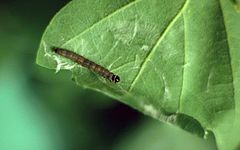|
Archips xylosteana
Archips xylosteana, the variegated golden tortrix or brown oak tortrix, is a moth of the family Tortricidae. DistributionThis Palearctic moth is widespread in most of Europe, in Asia (China, Iran, Japan, Kazakhstan, Korea, Siberia, Turkey), and in northern Africa (Algeria).[2][3][4] HabitatThis moth species inhabit woodland and scrub in hilly and mountainous areas.[5][6] DescriptionArchips xylosteana is a medium-sized to large moth with a wingspan reaching 14–23 millimetres (0.55–0.91 in).[6] The females are usually slightly larger than the males. The basic color of the fore wings varies from yellow-brown or ocher to pinkish brown, mottled with dark reddish brown markings. Forewings are broad and roughly rectangular. Hind wings are light grayish brown.[4] The design of the wings may appear lightly asymmetric, because at rest one of the wing covers the other[4] and hides part of it. The caterpillar varies from whitish gray to bluish with greenish reflections and have a black head.[4] Meyrick describes it - Forewings with termen sinuate, vertical, costal fold from base to 3/5, irregular; ochreous more or less fuscous-tinged, paler towards costa; a transverse dorsal spot near base, central fascia with anterior edge sinuate, costal patch broadly connected with it near costa, a blotch from above tornus sometimes connected with costal patch, and an apical spot dark ferruginous-brown. Hindwings grey, apex sometimes yellowish-tinged. Larva whitish-grey or pale greenish; head black;plate of 2 black, anterior edge white.[7] Julius von Kennel provides a full description.[8] BiologyThese moths fly from June to August in one generation.[4][6] They rest during the day in the foliage of trees and shrubs. Their activity begins at dusk.[6] They overwinter on tree trunks and thick boughs. Caterpillars grow protected in a rolled leaf, perpendicularly to the midrib, from April to June. These larvae are polyphagous, feeding on various shrubs and deciduous trees,[4] mainly oak (Quercus), elm (Ulmus), linden (Tilia), hazel (Corylus), maples (Acer), ash (Fraxinus, firs (Abies), brambles (Rubus), honeysuckle (Lonicera) and St John's worts (Hypericum)).[5] They can also be found on various fruit trees (apple, pear, etc.) [9] and on some herbaceous plants. Gallery
Bibliography
References
External links |
||||||||||||||||||||||||||||||
Portal di Ensiklopedia Dunia




